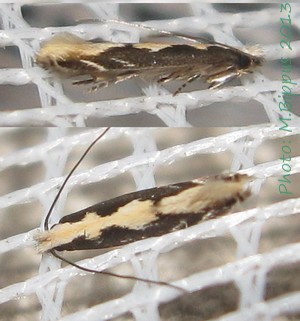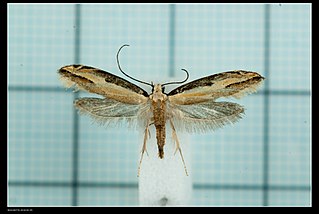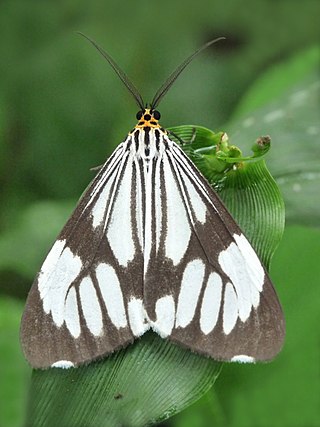Related Research Articles

Hasora badra, the common awl, is a butterfly belonging to the family Hesperiidae, which is found in India.

Cepora nadina, the lesser gull, is a small to medium-sized butterfly of the family Pieridae, that is, the yellows and whites. The species was first described by Hippolyte Lucas in 1852. It is native to Sri Lanka, India, Myanmar, Hainan, and southeast Asia.

Maoricrambus is a genus of moths of the family Crambidae. It contains only one species, Maoricrambus oncobolus, which is endemic to New Zealand. This species is classified as Nationally Endangered by the Department of Conservation.

Amphixystis is a genus of moths belonging to the family Tineidae. The family was first described by Edward Meyrick in 1901.

Tineovertex is a genus of moths belonging to the family Tineidae.

Sabatinca calliarcha is a species of moth belonging to the family Micropterigidae. It was described by Edward Meyrick in 1912. It is endemic to New Zealand. It is found in two separate areas of New Zealand - the first in the norther parts of the North Island including Great Barrier Island and the second population can be found from the top of the South Island down to Southland. The adults of the species are on the wing from the end of September until the middle of January. The species prefers to inhabit damp forests and larvae likely feed on leafy liverwort species. Adult moths likely feed on the spores of ferns or the pollen of sedge grasses.
Petasactis is a genus of moths belonging to the family Tineidae. It contains only one species, Petasactis technica, which is endemic to New Zealand. This species has not been collected since prior to 1888. It is classified as "Data Deficient" by the Department of Conservation.

Nyctemera coleta, the marbled white moth or white tiger moth, is a moth found from India to the Philippines, and from Japan to Papua New Guinea. It is classified under the subgenus Coleta of the genus Nyctemera in the family Arctiidae. The species was first described by Caspar Stoll in 1782. It contains four subspecies.

Philonome lambdagrapha is a species of moth of the family Tineidae. It is found in French Guiana.
Helcystogramma phryganitis is a moth in the family Gelechiidae. It was described by Edward Meyrick in 1911. It is found in Sri Lanka.
Helcystogramma rhabduchum is a moth in the family Gelechiidae. It was described by Edward Meyrick in 1911. It is found in Sri Lanka and India.
Photodotis prochalina is a moth of the family Gelechiidae. It was described by Edward Meyrick in 1911. It is found in South Africa.
Amphixystis fragosa is a moth of the family Tineidae. This species is known from Mauritius and Réunion. On Réunion, adults are on wing year-round.

Erechthias indicans is a species of moth in the family Tineidae. It was first described by Edward Meyrick in 1923. This species is endemic to New Zealand and has been observed in Wellington in January.

Sagephora felix is a species of moth in the family Tineidae. It was described by Edward Meyrick in 1914. This species is endemic to New Zealand and can be found in the north half of the North Island. It inhabits native forest and adults of the species are on the wing from December to May, in July and November.
Edosa opsigona is a moth of the family Tineidae first described by Edward Meyrick in 1911. It is found in Sri Lanka.
Pammenemima ochropa is a moth of the family Tortricidae first described by Edward Meyrick in 1905. It is found in Sri Lanka and its Barberyn Island.
Lobesia fetialis is a moth of the family Tortricidae first described by Edward Meyrick in 1920. It is found in India, Sri Lanka, Java and Sumatra.
Cryptaspasma brachyptycha is a moth of the family Tortricidae first described by Edward Meyrick in 1911. It is found in Sri Lanka and Australia.

Tingena chloritis is a species of moth in the family Oecophoridae. It is endemic to New Zealand and has been found in the South Island. Larvae of this species feed on leaf litter. The adults of this species are light flyers and are attracted to light.
References
- ↑ "Species Details: Tineovertex melliflua (Meyrick, 1911)". Catalogue of Life. Retrieved 29 May 2018.
- ↑ Koçak, Ahmet Ömer; Kemal, Muhabbet (20 February 2012). "Preliminary list of the Lepidoptera of Sri Lanka". Cesa News. Centre for Entomological Studies Ankara (79): 1–57 – via Academia.
- ↑ "A revision of the genus Tineovertex Moriuti (Insecta: Lepidoptera: Tineidae), with descriptions of five new species" (PDF). Zootaxa. Retrieved 28 March 2018.